
Issue 8
March 2022
Hello and welcome to the March issue of the My Lovely Horse Rescue Newsletter!
It’s long been said that March comes in like a lion but goes out like a lamb. We’ve had our share of being jostled about with storms in the past month and we’re keeping our fingers crossed that milder weather will arrive in time for St. Patrick’s Day!
In February we took 45 animals into our care. Every soul has been welcomed with open arms and we will love and care for them until they find the forever homes they truly deserve. We are delighted that in the past month, 21 animals rescued by MLHR found their forever homes and we wish them every happiness!
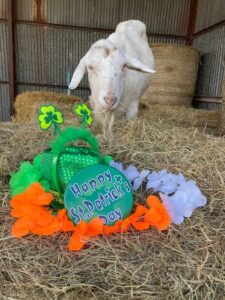
In our Arrivals Lounge this month, we have the pleasure of introducing you to little Neo, simply the cutest piglet ever. In our Departures Lounge, we say a fond farewell to Jermaine as he heads overseas to his forever home in Switzerland.
March’s Story of the Month features a special look at animals under the shadow of war.
Our Day in the Life series looks at Hepatitis and how it is affecting our beautiful friend Amanda. Our Mini Section features Polly Pockets, a remarkable pony who has overcome unthinkable trauma and has learned to trust again. Over in our Did You Know? section our farm friends are modelling for us once more as we look at Horse Coat Colours.
With bargains from My Lovely Charity Shop and The Tack Shack, our Recipe of the Month and some heart-warming, feel-good photos and videos from Behind the Scenes at MLHR and MLPR – we have everything you need to kick-start your month!
As always, we are here for the animals because you are here for us. We are so grateful for your continued support. Thank you for subscribing!

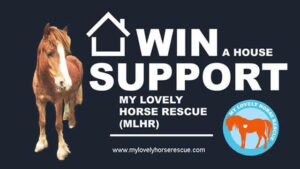


Arrivals – Neo
Little Neo has stolen our hearts. From a very rough start when he found himself in an Irish pub with some unscrupulous owner trying to sell him and jokes being made all round about how best to cook him he has landed firmly on his little feet now. Some wonderful people came to his aid and brought him to us where they knew he would always be protected. Neo is one of the very few lucky piglets out there. We have no idea where his brothers and sisters may be but at least he is safe now.
He’s a glorious little chap, full of beans and loving his tiny precious life. He adores his grub, perhaps a little too much at times and he spends his day eating, sleeping and exploring the large pig shed he lives in and meeting all the other residents. He has a little eye infection but that’s healing well, as are his poor little legs which were very raw, probably due to the ammonia from the urine and faeces of wherever he was born. No need to worry about dirty straw or cold floors anymore, Neo is in the lap of luxury and we can’t wait to share his journey with him as he grows big and strong.
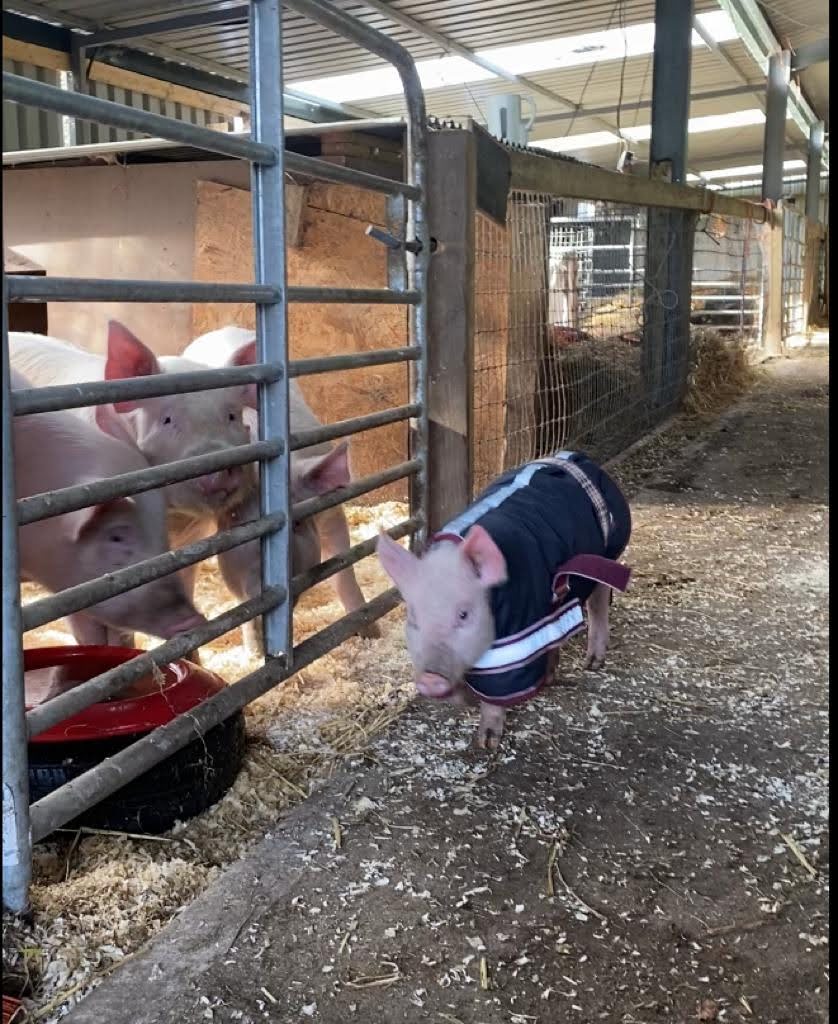
Departures – Jermaine
Recently we waved a bon voyage to our lovely Jermaine as he went off in style with PT International Horse Transport from the Cork farm to start his new life in Switzerland. Irish horses, especially Irish cobs are really loved on the continent and we have sent at least a dozen over the Irish sea at this stage. We go through a rigorous screening process to find really amazing homes for these youngsters and are so grateful to everyone along the way who helps make all this happen.
Jermaine has actually been adopted by one of our very own MLHR volunteers Susanna who has come to Ireland a few times to volunteer alongside her friend Chrissy. They are two of the kindest, most positive people you could hope to meet so we had no hesitation in allowing Jermaine off to live with them.
We think Jermaine would probably get on well anywhere. He’s just such a laid back chap, very much likes to do his own thing and has never shown much concern for knowing his place in the pecking order. His two good friends on the farm, Damien and Alec, are much more understanding of the importance of seniority especially amongst the older horses. There is a social hierarchy with horses as there is with us all in life and when they line up for feeds everyone knows his/her place. Jermaine though would just toddle up to the front of the queue and sandwich himself between Misty & Loveday, our two most senior mares, big 17h girls. No amount of squealing or swinging at him from them made the slightest bit of difference and in the end they just gave up and let him be.

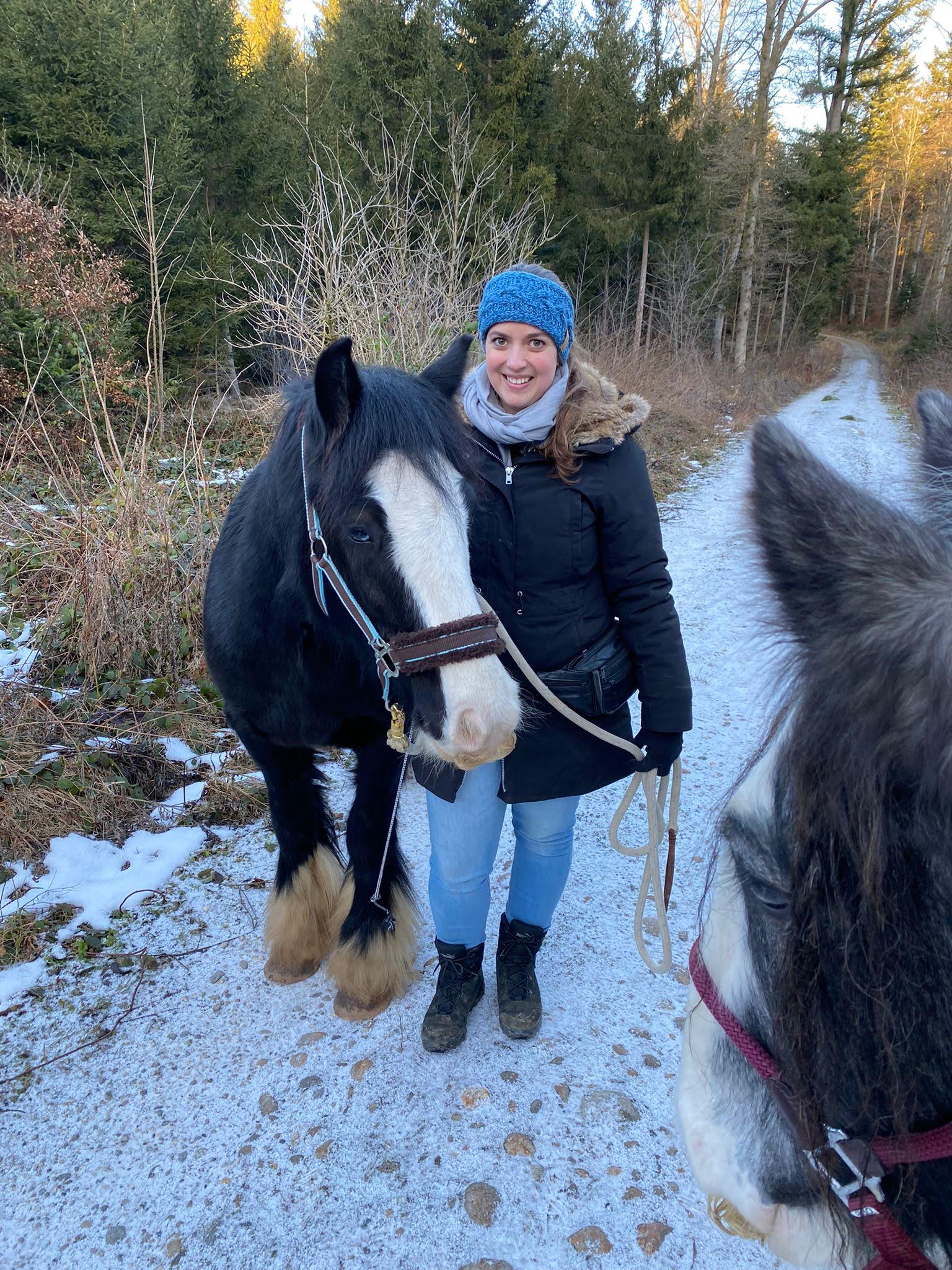
If anyone on the farm got into mischief you could pretty much lay a bet it’d be Jermaine. Such a funny, independent personality but also very placid, kind and loyal to his friends as the following ‘haybell’ story will show.
Early one morning Damien, in his silly greed, was trying to get at the last few strands of hay in one of our haybells and somehow managed to get himself wedged in there. A red alert went out for our Cork volunteers and they rushed up to the farm before work. Damien was well stuck and couldn’t get himself out. Some of the other horses decided to take advantage of poor Damien’s plight by going over and taking swipes at him from both sides. No sooner did this start than up canters Jermaine and Alec. They placed themselves firmly on both sides of Damien and protected him until the humans got him unstuck which luckily was soon accomplished.
In the days coming up to his departure, Jermaine loved all the attention as he was groomed and manicured and he proudly modelled his new travel rug sent specially for his trip. It was a long journey but with plenty of stops and well fed and watered along the way he arrived all ready for his new life in the beautiful Swiss countryside. This is what it’s all about and why we do what we do, happy endings like this help to motivate us for the sadder times too.
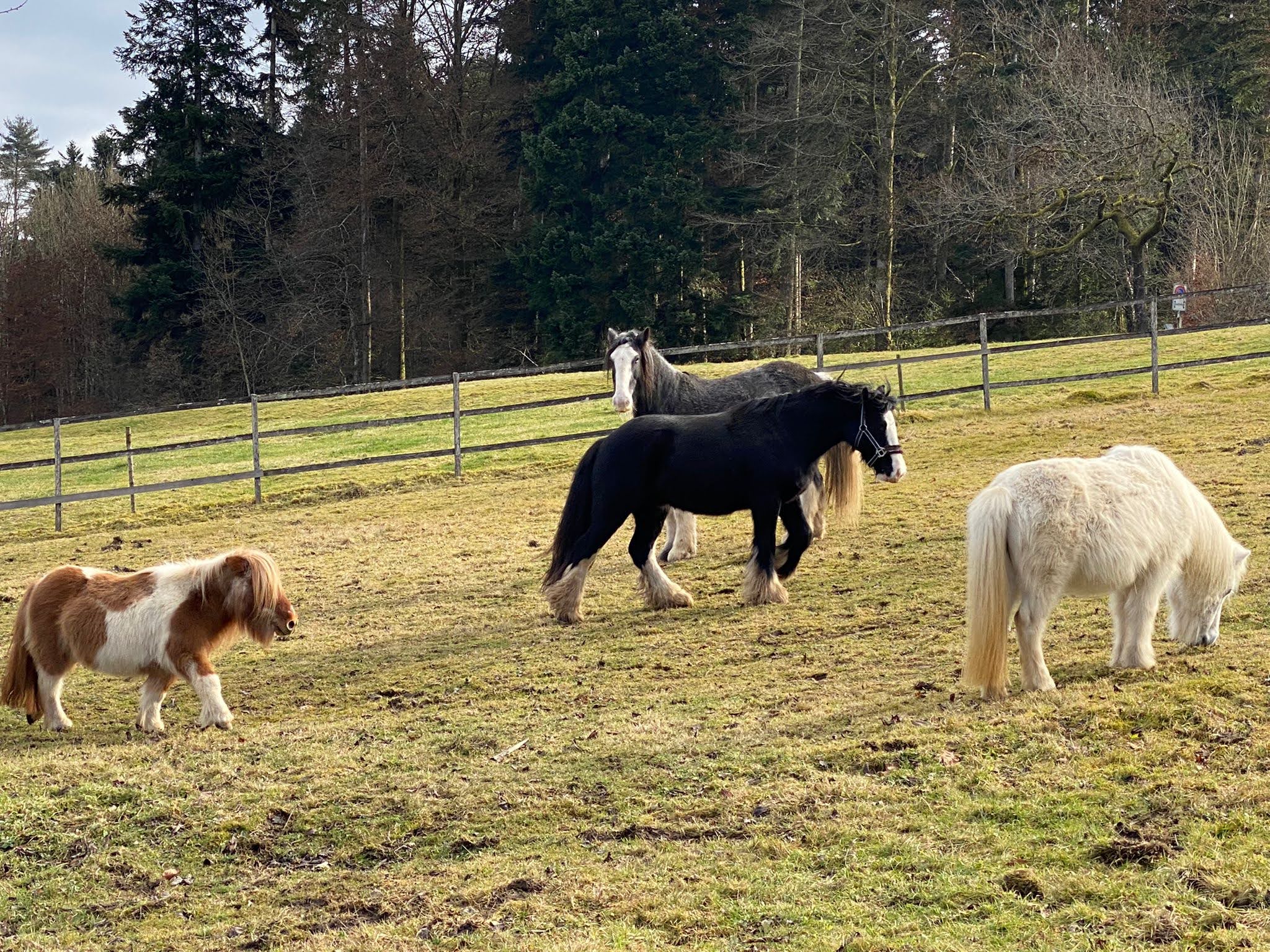

Animals are war victims too
In view of the huge tragedy unfolding in Ukraine right now and the horrific sight of people fleeing their homes with their loved ones, including their four legged family members, we have decided for our story of the month to focus on animals and the amazing part they have always played by our side, even in times of war and destruction. They are the unsung heroes of our lives during times of crises when we face the gravest of perils and their stoicism and bravery is simply amazing. They are also often very dependent on us to look after them and help them survive. This story is dedicated to all the animals of Ukraine and to their human protectors.
Animals have been by our side for as long as recorded human history. There is a part of us, whether we all realise it or not, which is deeply connected to the animal world around us. After all we came from that world too before we decided to build our cities and pave the world in concrete. Our hearts beat to the same rhythm and we all live short, transient lives here on this pale, blue dot we call home. As we welcomed animals closer and closer into our lives over time we discovered the richness of that relationship which they had to offer. They have become our friends, they love us and so often give us an amazing sense of well being when we are around them. It’s as if they transmit some gentle signal to help us relax and forget the harsh stresses of the modern lives we lead.
Their bravery is astounding. Throughout history they have faced many wars by our side and though we have often asked way too much of their loyalty and courage, they have stayed beside us. They have lived that peril with us, bringing comfort in the midst of extreme darkness and evil. They have carried our soldiers through the toughest of battles and been their staunch companions even to the death.
They have lugged our weaponry over terrain that was too rough for our modern machines. They have brought our wounded to field hospitals and brought essential supplies to the frontline.
They have gone ahead to sniff out landmines and clear the way for us and they have done it all with a gentle, stoic nature that has never failed us.
Though modern warfare does not need animals as all wars once did yet still they serve beside us, as companions, as bomb detectors, as sniffer dogs to find us amongst the rubble that our bombs create.
So it has touched a deep chord with everyone all over the world to see the people of Ukraine, with all the hardship that they are facing, cling to their animals and flee with them from the onslaught of bombs and tanks and foreign soldiers on their soil.
Seeing that love and kindness shown to creatures who, were they left behind, would simply not understand why they were abandoned and would find it very difficult to survive, has given us all a glimmer of what it should mean to be human, to have humanity and all the traits that we associate with that word, compassion, empathy, generosity of spirit. These images have struck a chord because they are in complete juxtaposition to the images of the tanks and the bombs and the huge inhumanity of the war beast which is rolling relentlessly across the Ukraine.
We owe our animals a better world just as we owe our children a better one. They are completely defenceless and desperately need our help. We have no words to say how much we admire and love all those wonderful people who are out there right now working to protect the animals caught up in this horrific crime against humanity. We wish you all the light and love that we have and we hope for a brighter dawn for you all.

Amanda’s Story
When an animal comes into our care, our priority is always creating a safe space for them, somewhere they feel secure and can trust that they will have shelter, a soft bed to lie down in, enough food to eat and water to drink. Each animal entering the rescue is examined by our Vets. Sometimes it is clear from the outset what the treatment plan for an animal will be. Sometimes the pieces of the puzzle come to us gradually and sometimes as we get the answers to one medical conundrum, another arises. Such has been the case with our beloved Amanda.

Amanda is a Dark Bay Shetland pony who came into our care in April 2021. She is quiet and a little nervous and at almost 18 years, she has endured a lot in her life. Amanda was clearly in pain from the time she came to us and we suspected she had laminitis. An examination by our Farrier found bruising on her two front feet. Bacteria in a bruised area can cause painful abscesses to form so over the next few weeks, we poulticed Amanda’s feet to draw out any infection and when she had healed, she was shod to protect her feet.
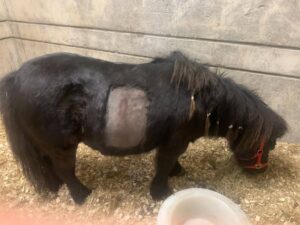
At Amanda’s initial Vet check-up it was discovered that she has four diastemata (gaps) between her back teeth. Diastema can cause abnormal chewing and results in food becoming lodged between the gum and the tooth. It can be extremely painful as it becomes packed and presses down on the tooth and the nerves. Amanda will need regular dental checks to manage this. The more surprising outcome of this visit was that our Vet suspected that Amanda was pregnant – a blood test confirmed this.
Over the next few months, as the issues with Amanda’s feet and teeth were being brought under control, her
pregnancy was progressing normally. An ultrasound in September confirmed that she was due to give birth in November. By late November, she had not begun to show any of the usual signs of being close to foaling. This was not in itself a cause for concern and a checkup revealed nothing abnormal.
It was unexpected and utterly devastating when Amanda lost her foal on 30 November 2021. Her beautiful little filly was named Angel Amanda. While we wanted so badly to be close to Amanda, to comfort her, we knew we had to respect her need to be alone with her baby and to grieve and mourn her loss in her own way for as long as was right for her. We gave her all the time and space she needed.
What we do to help Amanda
Blood tests taken as part of Amanda’s after-care showed that her liver enzymes were elevated and she was referred to UCD in December for further tests and a liver biopsy.
Additional blood results showed that she was mildly anaemic but the liver biopsy concluded that she has Hepatitis – swelling of her liver. It was not the news we hoped for but we don’t give up on any animal in our care so we will do whatever it takes to treat Amanda and keep her comfortable. We can’t say for sure what caused the problems with her liver, whether it was the result of toxins or a bacterial infection but we dread to think of how long she may have been left suffering without the appropriate care or medical intervention.
In January, Amanda’s bloods were tested again as the membranes in her eyes were showing signs of jaundice, a symptom of Hepatitis.
We started Amanda on a course of Liver Restore Tonic which is given orally with a syringe. Restore is a blend of antioxidant herbs which cleanse the liver, support digestion and help Amanda to filter toxins from her body. She showed some signs of improvement, and the jaundice in the membranes in her eyes seemed to have decreased.
Amanda also had a delousing treatment as we noticed that she began to lose patches of hair and her skin had developed small sores. Skin scrapings and samples were taken by our vets to determine the cause and we continue to manage her symptoms by applying cream to her skin to ease any irritation and discomfort.
Amanda has been through more than most animals during her time with us. Now that we have a diagnosis, we can tailor her supportive care. She may need steroids or antibiotics in the future to manage flare ups in her condition but for now, she is doing well. She is in good form and we are continuing to closely monitor her demeanour, make sure that she is eating well and that she is comfortable and happy.
Amanda spends most of her time on the main yard supervising the farmies. She has become closely bonded with Indie, a piebald cob who has no problems in the confidence department. Where Indie goes, Amanda is not far behind. They can always be found together, either grooming one another or standing next to one another as they doze.
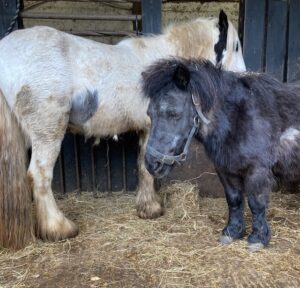
Indie clearly brings comfort to Amanda and has really helped her to come out of her shell that little bit more. The upside to frequent vet checks is that Amanda has become more accustomed to spending time with humans. It has taken a long time but she is learning that she is safe and she can trust us never to harm her.

Welcome to our mini section where each month we will feature one of our smaller pony breeds for you. They can be so adorable yet feisty for their size and often well able to take on the larger horses who simply look bemused at these tiny creatures giving them attitude. Minis like shetlands and falabellas are often mistreated in this country, ridden by kids or adults who are way too big for them. We just adore all our smallies as we often call them and we look forward to bringing you their stories each month
Polly Pockets
Our little Polly Pockets is one of our most loved smallies and some of you may remember her from her terrible ordeal of being kidnapped from us a couple of years ago, but more of that in a minute. Little Polly came to us originally from Waterford as a young baby after her mother had died. Such a tiny little thing she was. You could pick her up with no effort at all. We all fell in love with her and she with us. She followed everyone around the yard and soon her wonderful, feisty little character came to the fore. She was always bubbly and playful, nibbling at you and trying to get your hat off when you went down to hug her.
Then tragedy struck. Polly went missing. One evening she just didn’t come in with the rest of the herd from the fields and though everyone searched for hours there was no sign of her. Then we knew that someone had come and kidnapped our Polly so we launched a massive social media campaign to find her and to make her way too hot for her kidnappers to handle. She was so small and vulnerable and we just couldn’t bear the thought of her out there somewhere, all alone and frightened. Amazingly she was eventually found by a woman out walking her dogs in woodland in Louth where the thieves had obviously dumped her.
The call that day to say ‘I think I’ve found your Polly’ was one of the most amazing calls we’ve ever received. We couldn’t believe she was coming home again.
But the little Polly who came back to us was very much changed, not only physically – the kidnappers had plucked out the white star on her forehead and painted her hooves black – but she herself was changed too. When Debs went to collect her she was so defensive and actually turned around to try and kick out. Whatever had happened to Polly in those weeks left a deep scar on her. She didn’t know who to trust and she didn’t feel safe anymore. The wonderful little Polly that we knew was lost somewhere inside and we had to find her again. So she went to live with one of our longtime volunteers Tarah, who now helps manage our MLPR farm. Tarah remembers the first time she saw Polly after her return to the farm, standing all alone in the corner of one of our fields with her little head through a fence and looking absolutely miserable. We needed our bubbly little girl back again so off she went to join Tarah’s other three horses. It took a long time, nearly a year really until Polly regained her old sense of self. She had become very defensive and also very food aggressive, even with grass as Tarah’s aunt discovered when she went over to say hi and nearly got knocked over. Polly had always been a very strong character with her own boundaries and now those boundaries had been violated and she needed to believe that she could trust people again. So with a lot of consistent TLC and also a lot of respect for Polly’s space and watching her for cues on how much interaction she wanted or needed we saw the old Polly begin to emerge. She is as feisty as ever and certainly won’t take crap from anyone but she trusts us all again. She lives now with Tarah’s little herd of four where she just loves her life so much. Gordi is her main little buddy and they have the best fun together. She still trots off on her own when she needs a bit of space but she loves everyone again and appreciates the one on one time that she gets too. She has even made up with Tarah’s aunt and loves being groomed by her!
Animals suffer just like we do and sometimes, just like us, it can take them a very long time to recover. But as with any of us, love, patience, compassion and just being there for them can make all the difference.
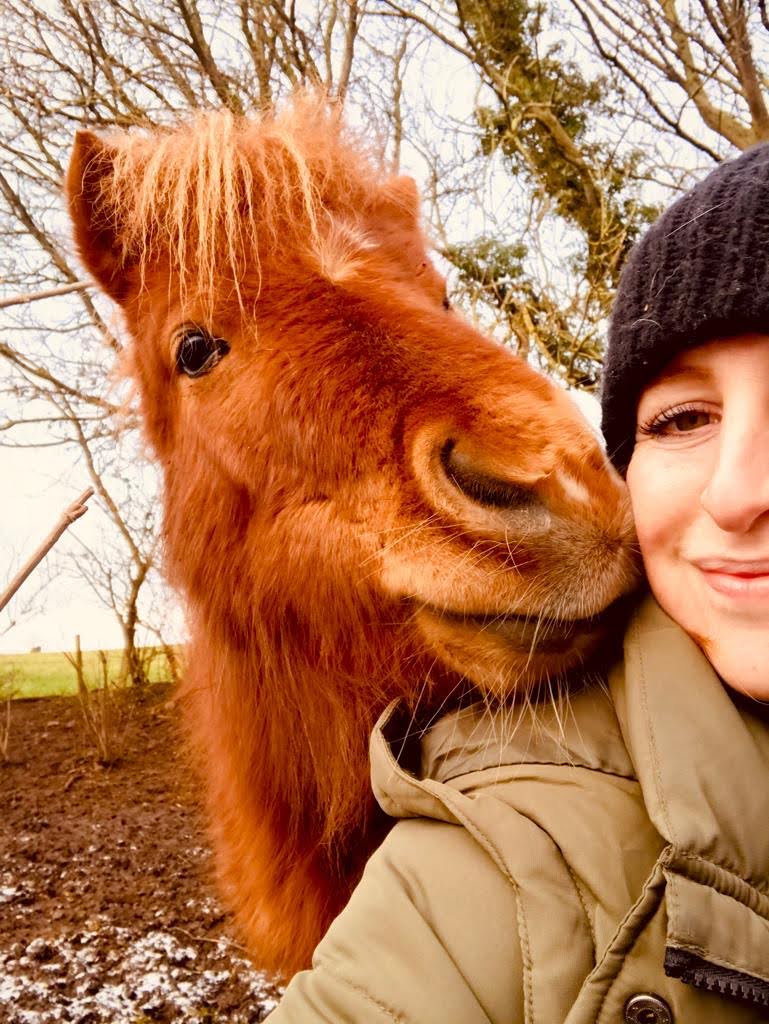
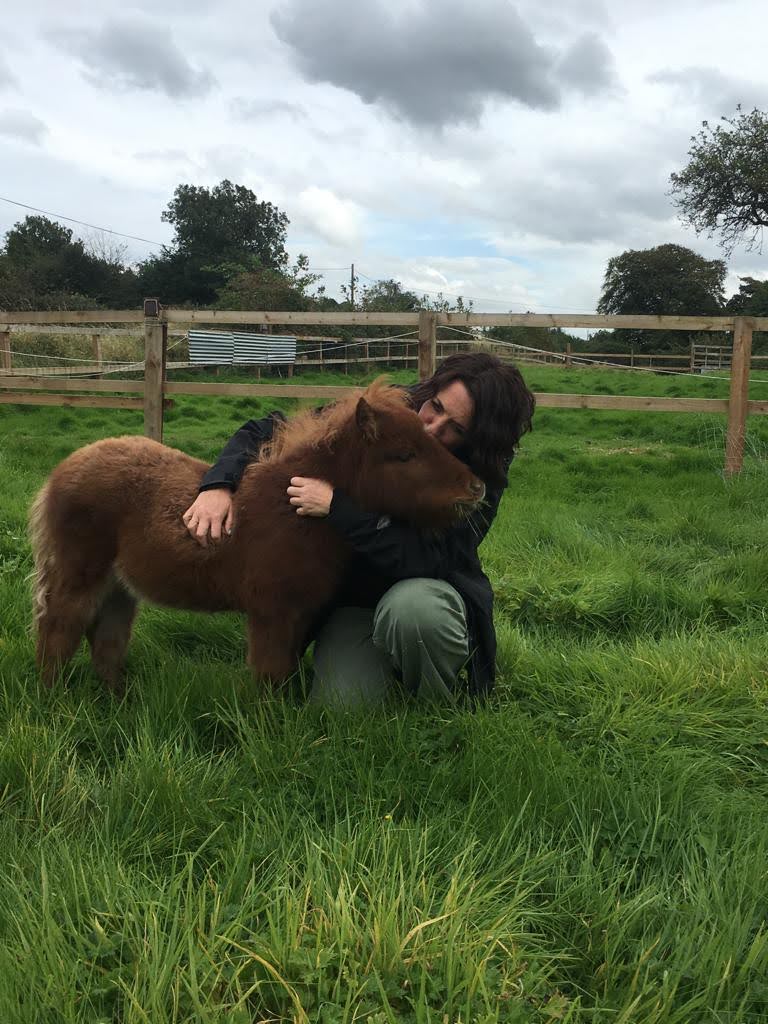

Horse Coats of Many Colours
Discussions about horse colours can get quite technical here at MLHR. It’s not as simple as pointing to the brown horses in the field – because, well, are they brown? Or Bay? Maybe Dark Bay? Light Bay? Liver Chestnut? What exactly is it that determines the difference? Let’s talk genetics … briefly!
Did You Know that in 2006 the Equine Genome Project set out to sequence the horse genome? The horse genome is the complete set of genetic instructions for the horse containing all chromosomes and inheritable traits. In short, sequencing that genome means testing DNA in order to read how its building blocks are ordered and work together to create a living, breathing horse, in this case, a thoroughbred mare named Twilight.
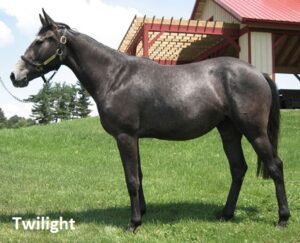
The project’s findings were published in 2009 and were responsible for major advancements in equine science. They were key to understanding and treating equine diseases and pinpointing others that are breed specific. They also gave us answers to important questions like ‘how is it that horses come in more shades than Joseph’s Technicolour Dreamcoat?’
According to Dr Kathryn Graves of the Gluck Equine Research Centre in Kentucky, horses have three base colours, black, bay and chestnut, and it is from these that all other coat colours and patterns come. The base colours are controlled by their interactions with two genes – the Extension gene, which is responsible for the expression of black pigment, and the Agouti gene, which is responsible for where black will be expressed in the horse’s coat, for example on the horse’s ears, mane, tail and legs. There are also modifier genes and dilution genes which further affect the colour of the coat and while it is a fascinating area of study, here at MLHR we can simplify things even further.
Since our facial markings fashion show in the December issue, our farm friends have been eager to model in the newsletter once more, so here are some visual clues to help you identify coats of many colours.
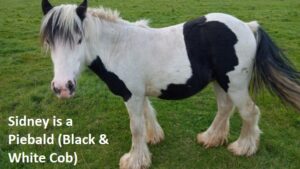



A Piebald coat is usually categorised as having black or white patches whereas a Skewbald coat has patches of other colours, such as red and white, as modelled by Ezra. A Tricolour horse may have white, brown and black patches. A Chestnut coat is solid red colour across the whole coat as modelled by Clare. Isola is a Brown Roan pony; her face is brown and there is a mix of mix of white and other colours across her coat giving her a bluish-grey hue.

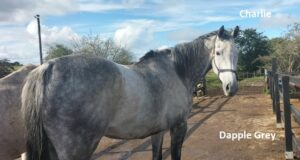
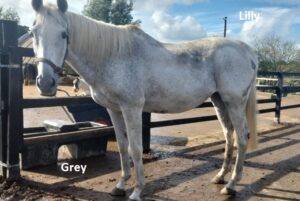
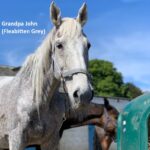
Baron is a Light Bay. His coat is a reddish-brown coat and he has a black mane, tail and four black legs. Amanda from our Day in the Life section, is a Dark Bay, her coat is a deep brown colour. Charlie’s coat is Dapple Grey – he has darker rings (dapples) across his grey coat. Horses with a Dapple Grey coat usually change to all grey by the time they reach 10 years of age. Lilly (Charlie’s Mum) is Grey. Finally we have Grandpa John, who has a Fleabitten Grey coat. As John has gotten older, his coat has developed tiny speckles of brown, like freckles. To some they look like Flea bites, hence the name.
So there you have it, a very short introduction to just some of the colours horse coats come in, a topic we will surely return to as more of our friends offer their modelling services!

Our shop is a treasure trove – you never know what you might find! Those who follow us on Facebook will know that we’ve had some fantastic pieces donated to the shop in the last month, some items have barely been worn, others never worn and have been gifted to us with the tags still attached.
It’s all about footwear this month and we’re highlighting some of the bargains on offer. In our Shoe Zone, we have a great selection of court shoes and flats which are perfect for work, heels and knee-high boots for those much-missed nights out as well as trainers and ankle boots for down-time. In our gents section, we have formal shoes, trainers and loafers all in excellent condition and just waiting to be snapped up!
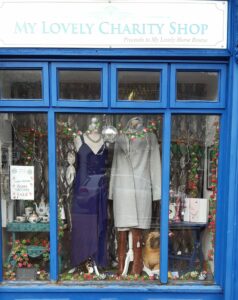
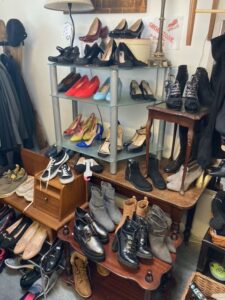
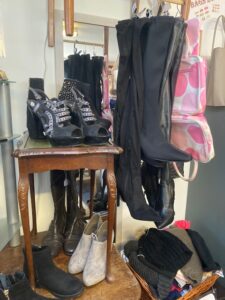
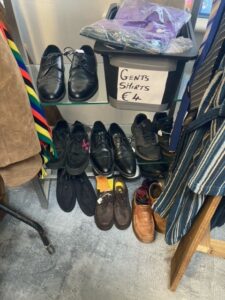

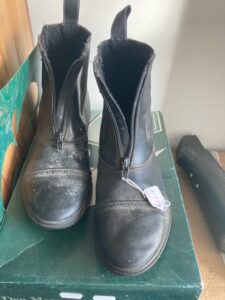

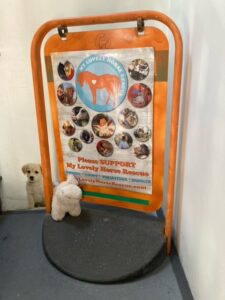
Upstairs in the Tack Shack, we have a wide selection of Wellies in various colours and sizes as well as riding boots for kids and adults. Size 41 Paddock boots, which can retail at €50, are a steal at €6. Size 29 Dublin brand Riding Boots are just €10 – incredible quality at an unbeatable price.
For the latest news from the shops, please follow My Lovely Charity Shop and My Lovely Tack Shack on Facebook or, if you fancy a leisurely browse, drop in to 81 JKL Street, Edenderry, Co. Offaly. Opening hours are Tuesday to Friday 10.30 a.m. – 4.30 p.m and Saturday from 10 a.m. to 3.00 p.m.
We are looking for Volunteers to join the team at My Lovely Charity Shop! If you are interested and can spare a day per week or per month, especially on a Saturday from 10 a.m. to 3 p.m., please get in touch on 086 844 5076 – we would love to hear from you!

As part of our mission here in My Lovely Horse Rescue we are trying to promote greater awareness of all animals’ needs, not just horses but especially the farm animals of the world who have such short and miserable lives before they go on their final journey to slaughter.
Many of us in MLHR have begun our vegetarian and vegan journeys over the last few years, inspired by the animals we’ve met on our farm bases. Something we’ve all learned is that every little counts and every time you opt for an animal-product free meal you are making a difference – even if you can’t do it everyday. We want to inspire as many people as possible to go on this journey with us, so every month we’re including a different vegan recipe for you to try out and enjoy.
This month we have our very easy to make Gingersnap Cookies! ?
Ingredients:
100g flour
1 tsp ground ginger
50g plant based butter
50g sugar
1 tbsp maple syrup


Method:
- Sieve the flour and ginger into a bowl and mix.
- In a small saucepan melt the plant based butter, sugar and maple syrup over a low heat until fully melted, set aside to cool slightly.
- Once cooled, add into your dry ingredients and mix together until a dough forms.
- Line a baking tray with parchment.
- Take small chunks of dough and roll into a ball in your hand. Place on the baking paper and flatten slightly with a fork. Flatten horizonally and then vertically to get a criss cross pattern on top of your dough.
- Bake for 15 minutes at 180°C or until golden brown.
- Allow to cool before eating and enjoy!

February’s storms brought very heavy rainfall, sleet, snow and damaging winds. There were national warnings to stay at home and not to venture out in these life-threatening conditions. For Ireland’s abandoned animals, without homes, without shelter, this was a particularly horrific time. As rivers burst their banks we received so many reports from members of the public of animals stranded in flooded fields, animals in immediate danger of drowning.
We have taken in so many horses and donkeys in the last few months who have been abandoned in appalling conditions, with no access to food, water, shelter or medical care. Animals are still facing unthinkable hardship and neglect. We are here for them 365 days a year but we need your support more than ever to give these animals a life worth living.
We are aiming to raise €150,000 to see us through this particularly difficult period in the wake of a cruel, relentless winter. Our running costs last year almost reached a staggering €400,000 with basic necessities of hay, feed, medical and farrier care accounting for over half of that figure. With over 500 animals already in our care across our three farms, this number is rapidly increasing as we take in sick and injured animals in desperate need of our help.
Your love of animals and your support means the world to us. Please help us provide a home, food and medical assistance to the animals in our care by donating what you can to our Winter Appeal.

Our farmies work from morning until night to keep the farms running and all the animals cared for. Between cleaning, feeding preparation, medical treatments and call outs, they capture so many moments on camera, from the interesting, to the funny and tender. Here are some ‘behind the scenes’ videos and photos from the farm this month. Enjoy!


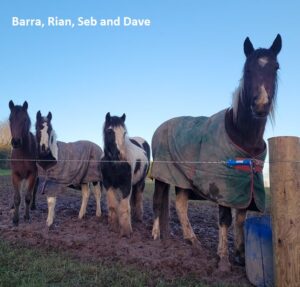
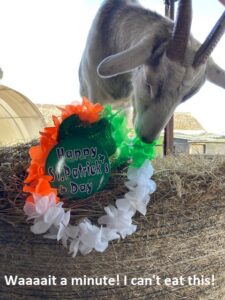
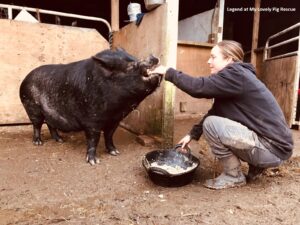
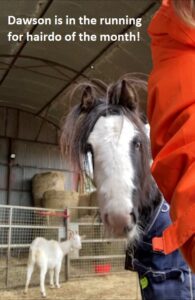
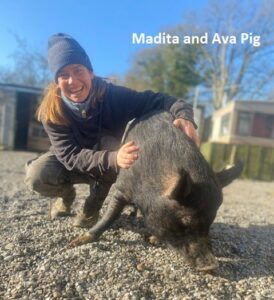
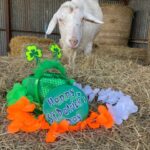

It’s terrifying to witness an act of cruelty against a defenceless animal or to see an animal running loose in the street perilously close to oncoming traffic. In the heat of the moment, it can be hard to know what to do, who to contact, and to know what information will be important to share. MLHR is on hand 24/7 all year round to be the voice for animals. Every day we receive reports from all over Ireland of animals (of all species) who are straying, who have been abandoned, or who have been the victims of intentional neglect and abuse.
Under the Animal Health and Welfare Act 2013, only Authorised Officers (An Garda Síochána; Department of Agriculture, Food and the Marine Inspectors; and County Councils/Local Authority Inspectors) are permitted to seize animals, to enter private property, to carry out investigations or to bring prosecutions. MLHR assists Authorised Officers with their work and for this reason, it is vital that members of the public reporting incidents to MLHR also report to the relevant Authorised Officers so that we can liaise with and help them move animals out of harm’s way and into safety.
What you can do
1. Provide us with a description of the animal(s) at risk and the nature of the incident.
2. Send us a pin drop or accurate description of the location.
3. Take Photographs/Video footage but only if it is safe to do so.
4. Tell us which Authorised Officer or Garda station you have contacted.
How to make contact with Authorised Officers
• An Garda Síochána – A list of Garda stations is available online at https://www.garda.ie/en/contact-us/station-directory/
• Local Authorities (for incidents on Public land) https://www.gov.ie/en/help/departments/#local-authorities
• ISPCA for emergencies call 1890 515515 (Monday to Friday 9 a.m. – 5 p.m.). Welfare concerns can http://www.ispca.ie/cruelty_complaint
• Department of Agriculture, Food and the Marine – for incidents on private land phone 01 607 2379 or 0761 064 408 or email [email protected]

Missed out on any of our old newsletters? No worries! Click the button to browse through all of our newsletters!

So emotional,in tears. Love the recognition of the poor people and their pets in Ukraine ???
Fantastic monthly read
Thank you Anna x